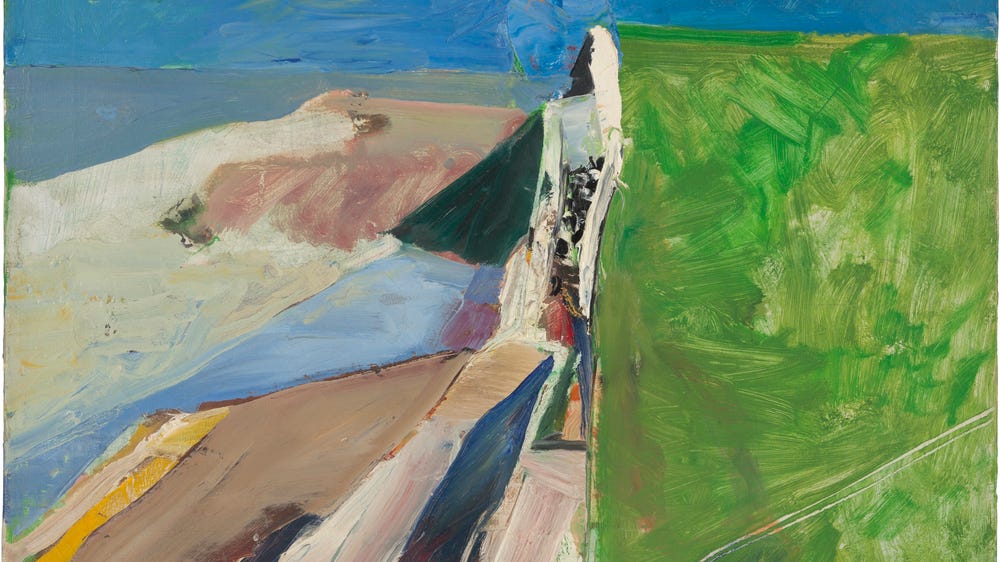Richard Diebenkorn, Seawall, 1957. Oil on canvas, 20 x 26 inches. Fine Arts Museums of San Francisco, Gift of Phyllis G. Diebenkorn, 1995.96 © 2013 The Richard Diebenkorn Foundation
SAN FRANCISCO—Richard Diebenkorn: The Berkeley Years, 1953–1966, on view at the de Young Museum from June 22 through September 29, 2013, will be the first exhibition to explore in-depth the work produced by Diebenkorn between 1953 and 1966, when he lived in Berkeley, California. The presentation will include over 130 of the artist’s paintings and drawings assembled from collections across the country, many of them rarely or never before seen in public exhibitions. Diebenkorn’s engagement with the unique settings of the Bay Area, along with his personal history, ties this exhibition deeply to the region.
Diebenkorn underwent a remarkable metamorphosis during what is now known as his “Berkeley period,” beginning with an abstract phase influenced by the Bay Area’s natural environment, and then moving to figurative works, including figures, interiors, and still lifes. Fiercely independent, Diebenkorn continued to explore his shifting conceptions of abstraction and figuration over these years, and rejected allegiances to schools or movements.
His challenge to prevailing orthodoxy also helped to elevate Diebenkorn’s national profile. As contemporaries like Willem De Kooning and Jackson Pollock wrestled publicly with Abstract Expressionism, Diebenkorn’s work offered another important perspective in the critical conversation of the time. His appearance in Life magazine, as well as an article titled, “Diebenkorn Paints a Picture” in ARTnews magazine, both published in 1957, further expanded the painter’s influence.
“It was during this period that Diebenkorn really became Diebenkorn,” says Timothy Anglin Burgard, the Ednah Root curator-in-charge of American art. “His artistic integrity rendered him immune to external pressure to conform to either abstract or figurative styles, and set a liberating example that seems remarkably prescient given the inclusive nature of the contemporary art world.”
Diebenkorn was profoundly influenced by the nature and culture of the Bay Area, and many of these works are saturated with light and atmosphere, as well as the deep reds, greens, and ochres of the region. Although born in Portland, Oregon, Diebenkorn grew up in San Francisco’s Ingleside Terraces neighborhood, attended Stanford University and UC Berkeley, and was both a student and an instructor at the California School of Fine Arts (today the San Francisco Art Institute).
Diebenkorn’s very first solo museum exhibition was held at the Legion of Honor in 1948, and Richard Diebenkorn: The Berkeley Years, 1953-1966 continues the Fine Arts Museums’ long engagement with the artist’s work. Though Diebenkorn would also make significant contributions to the modernist tradition through his work in New Mexico and Southern California—work celebrated in other recent exhibitions—Richard Diebenkorn: The Berkeley Years, 1953-1966 is a story rooted in the Bay Area, an exploration of one of the most complex and interesting chapters in postwar American art.
Exhibition Organization and Sponsors
The exhibition is organized by the Fine Arts Museums of San Francisco, in collaboration with the Palm Springs Art Museum. Curators Circle: Koret Foundation. Conservators Circle: Christie’s. Benefactors Circle: National Endowment for the Arts. Supported by an indemnity from the Federal Council on the Arts and the Humanities.
Visiting \ de Young
Golden Gate Park, 50 Hagiwara Tea Garden Drive, San Francisco, CA 94118
Museum Hours
Tuesday–Sunday, 9:30 am–5:15 pm. Friday (March 29–November 29, 2013) 9:30 am–8:45 pm. Closed Mondays.
Admission
Tuesday–Friday: $20 adults; $17 seniors; $16 college students with ID; $10 youths 6–17. Saturday–Sunday: $22 adults; $19 seniors; $18 college students with ID; $12 youths 6–17.
These prices include general admission. Members and children 5 and under are free. General admission is free the first Tuesday of every month.
Tickets can be purchased on site and online. Tickets purchased online include a $1 handling charge.
Group ticket reservations available by emailing groupsales@famsf.org.
About the Fine Arts Museums of San Francisco
The Fine Arts Museums of San Francisco, comprising the de Young Museum in Golden Gate Park and the Legion of Honor in Lincoln Park, is the largest public arts institution in San Francisco.
The de Young is housed in a copper-clad landmark building designed by Swiss architects Herzog and de Meuron. It showcases the institution’s significant collections of American painting, sculpture, and decorative arts from the 17th to the 21st centuries; art from Oceania, Africa, and the Americas; a diverse collection of costumes and textiles; and international contemporary art.
The Legion of Honor’s Beaux-Arts style building designed by George Applegarth is located on a bluff overlooking the Golden Gate Bridge. Its collections span 4,000 years and include European paintings, sculptures, and decorative arts; ancient art from the Mediterranean basin; and the largest collection of works on paper in the American West.
Images from all exhibitions and museums available upon request.
Media Contacts
Erin Garcia \ egarcia@famsf.org
Arlo Crawford \ acrawford@famsf.org
Clara Hatcher \ chatcher@famsf.org
